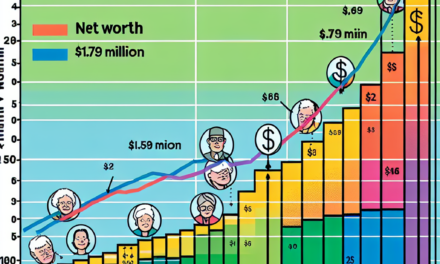“Steady Hands: Powell Signals Patience as Economy Thrives Without Rate Cuts”
Introduction
Federal Reserve Chair Jerome Powell recently signaled that there is no immediate urgency to reduce interest rates, citing the strength and resilience of the U.S. economy. Despite market speculations and pressures for rate cuts, Powell emphasized that the current economic indicators, including robust employment figures and steady growth, do not warrant a shift in the Federal Reserve’s monetary policy stance. His remarks underscore the central bank’s commitment to maintaining stability and controlling inflation, while carefully monitoring economic developments to ensure sustainable growth. Powell’s stance reflects a cautious approach, balancing the need to support the economy without overheating it, amidst a complex global financial landscape.
Analysis Of Powell’s Stance On Interest Rates And Its Economic Implications
Federal Reserve Chair Jerome Powell’s recent remarks have underscored a cautious approach to monetary policy, emphasizing a lack of urgency to cut interest rates despite a robust economic landscape. This stance reflects a broader strategy aimed at maintaining economic stability while navigating the complexities of post-pandemic recovery. Powell’s position is rooted in the current economic indicators, which suggest a resilient economy characterized by steady growth, low unemployment, and manageable inflation levels. By opting to keep interest rates steady, the Federal Reserve aims to balance the dual mandate of fostering maximum employment and ensuring price stability.
The decision to hold off on rate cuts is informed by several key economic factors. Firstly, the labor market continues to exhibit strength, with unemployment rates hovering near historic lows. This robust job market has contributed to sustained consumer spending, a critical driver of economic growth. Furthermore, inflation, while a concern in previous quarters, has shown signs of stabilization. The Fed’s preferred measure of inflation, the Personal Consumption Expenditures (PCE) price index, indicates that price pressures are moderating, reducing the immediate need for rate adjustments.
Powell’s cautious approach also takes into account the global economic environment. While the U.S. economy remains strong, uncertainties abroad, such as geopolitical tensions and varying recovery rates from the pandemic, pose potential risks. By maintaining current interest rates, the Federal Reserve retains flexibility to respond to unforeseen global economic shifts. This strategic patience allows the Fed to assess the long-term impacts of previous rate hikes and adjust policy as necessary without prematurely stimulating the economy.
Moreover, Powell’s stance reflects a broader consensus within the Federal Reserve that the current economic conditions do not warrant immediate intervention. The central bank’s decision-making process involves a careful analysis of economic data and projections, ensuring that policy actions align with long-term economic goals. By signaling no urgency for rate cuts, Powell communicates confidence in the economy’s ability to sustain growth without additional monetary stimulus.
However, this approach is not without its critics. Some economists argue that maintaining higher interest rates could dampen investment and slow economic momentum. They contend that preemptive rate cuts could provide a buffer against potential downturns, especially in light of external uncertainties. Despite these concerns, Powell’s strategy prioritizes a measured response, emphasizing the importance of data-driven decision-making.
In conclusion, Jerome Powell’s indication of no urgency for Federal Reserve rate cuts amid a robust economy highlights a strategic approach to monetary policy. By focusing on current economic indicators and maintaining flexibility in the face of global uncertainties, the Fed aims to support sustained growth and stability. While debates continue regarding the potential benefits of rate cuts, Powell’s stance underscores a commitment to careful analysis and long-term economic health. As the economic landscape evolves, the Federal Reserve’s approach will likely adapt, ensuring that policy decisions remain aligned with the overarching goals of fostering employment and maintaining price stability.
Understanding The Federal Reserve’s Approach To A Strong Economy
Federal Reserve Chair Jerome Powell recently signaled that there is no immediate urgency to cut interest rates, citing the robust performance of the U.S. economy. This stance reflects the Federal Reserve’s cautious approach to monetary policy, especially in an environment where economic indicators suggest sustained growth. Understanding the rationale behind this decision requires a closer examination of the current economic landscape and the Federal Reserve’s objectives.
The U.S. economy has demonstrated resilience, with key indicators such as employment rates, consumer spending, and GDP growth showing positive trends. Unemployment remains at historically low levels, suggesting a tight labor market that continues to support wage growth. Additionally, consumer spending, a critical driver of economic activity, has remained strong, bolstered by increased consumer confidence and disposable income. These factors contribute to a stable economic environment, reducing the immediate need for rate cuts.
Moreover, inflation, a primary concern for the Federal Reserve, has been relatively contained. While there have been fluctuations, inflation rates have generally hovered around the Fed’s target of 2%. This stability in inflation allows the Federal Reserve to maintain its current interest rate policy without the pressure to either curb excessive inflation or stimulate a sluggish economy. By keeping interest rates steady, the Fed aims to balance its dual mandate of promoting maximum employment and ensuring price stability.
In addition to domestic factors, global economic conditions also play a role in the Federal Reserve’s decision-making process. While there are uncertainties in the international arena, such as geopolitical tensions and trade dynamics, the U.S. economy has shown a degree of insulation from these external pressures. This resilience further supports the Fed’s position of maintaining current interest rates, as there is no immediate threat that necessitates a shift in policy to protect the domestic economy.
Furthermore, Powell’s indication of no urgency for rate cuts aligns with the Federal Reserve’s long-term strategy of gradualism. This approach emphasizes measured and predictable policy adjustments, allowing markets and economic agents to adapt without sudden disruptions. By signaling a steady course, the Fed provides clarity and stability, which are crucial for sustaining economic confidence and investment.
It is also important to consider the potential risks associated with premature rate cuts. Lowering interest rates in a strong economy could lead to overheating, where excessive borrowing and spending drive inflation beyond manageable levels. This scenario could necessitate more aggressive rate hikes in the future, which might disrupt economic stability. Therefore, the Fed’s cautious stance helps mitigate such risks, ensuring that monetary policy remains supportive of sustainable growth.
In conclusion, Jerome Powell’s indication of no urgency for Federal Reserve rate cuts reflects a comprehensive assessment of the current economic conditions. The robust performance of the U.S. economy, coupled with stable inflation and global considerations, supports the decision to maintain interest rates. By adhering to a strategy of gradualism and caution, the Federal Reserve aims to foster a stable economic environment that promotes long-term growth and stability. As the economic landscape evolves, the Fed will continue to monitor developments closely, ready to adjust its policy as necessary to fulfill its mandate effectively.
The Impact Of Steady Interest Rates On Financial Markets
Federal Reserve Chair Jerome Powell’s recent remarks have underscored a significant stance in the central bank’s monetary policy approach, indicating no immediate urgency to cut interest rates despite a robust economic landscape. This position has profound implications for financial markets, which are often sensitive to shifts in interest rate policies. As the economy continues to demonstrate resilience, the decision to maintain steady interest rates reflects a cautious optimism, balancing growth with inflationary concerns.
The Federal Reserve’s decision to hold interest rates steady is primarily influenced by the current economic indicators, which suggest a healthy expansion. Employment rates remain strong, consumer spending is robust, and inflation, while a concern, is not at levels that necessitate immediate intervention through rate cuts. By maintaining the current interest rates, the Fed aims to sustain economic growth while keeping inflation in check, a delicate balance that requires careful monitoring of economic data.
In the financial markets, the impact of steady interest rates is multifaceted. For one, it provides a level of predictability that can stabilize investor sentiment. When interest rates remain unchanged, investors can make more informed decisions regarding asset allocation, risk management, and long-term investment strategies. This stability can lead to increased confidence in the markets, potentially driving up stock prices as investors seek higher returns in equities compared to the relatively lower yields from fixed-income securities.
Moreover, steady interest rates can influence the bond market significantly. With no immediate rate cuts on the horizon, bond yields may remain relatively stable, affecting the pricing and demand for various fixed-income instruments. Investors seeking income through bonds might find themselves reassessing their portfolios, considering the trade-off between risk and return in a low-yield environment. Consequently, this could lead to a shift in investment strategies, with some investors opting for higher-risk assets in search of better returns.
Additionally, the decision to keep interest rates unchanged can have implications for the foreign exchange markets. A stable interest rate environment in the United States can influence the value of the dollar relative to other currencies. If other central banks opt for rate cuts while the Fed holds steady, the dollar could strengthen, impacting international trade and investment flows. A stronger dollar can make U.S. exports more expensive, potentially affecting the trade balance, while also making foreign investments more attractive to U.S. investors.
Furthermore, the housing market is another sector that feels the effects of steady interest rates. Mortgage rates, which are closely tied to the Fed’s interest rate policies, may remain stable, providing potential homebuyers with a clearer picture of borrowing costs. This stability can encourage home purchases and refinancing activities, contributing to the overall health of the housing market.
In conclusion, Jerome Powell’s indication of no urgency for Fed rate cuts amid a robust economy sends a clear message to financial markets: the current economic conditions do not warrant immediate monetary easing. This decision, while maintaining stability, requires continuous assessment of economic indicators to ensure that growth is sustained without triggering excessive inflation. As financial markets navigate this environment, the interplay between interest rates, investor behavior, and economic performance will continue to shape the landscape, highlighting the intricate connections between monetary policy and market dynamics.
How Powell’s Comments Reflect Current Economic Conditions
Federal Reserve Chair Jerome Powell’s recent comments have underscored a cautious yet confident stance regarding the U.S. economy, suggesting that there is no immediate urgency to cut interest rates. This perspective is rooted in the current robust economic conditions, which have shown resilience despite various global uncertainties. Powell’s remarks reflect a broader understanding of the economic landscape, where growth remains steady, inflation is relatively contained, and the labor market continues to exhibit strength.
To begin with, the U.S. economy has demonstrated a remarkable ability to sustain growth, even as it navigates challenges such as trade tensions and geopolitical uncertainties. The gross domestic product (GDP) has maintained a steady pace, supported by consumer spending, which remains a critical driver of economic activity. This consumer confidence is bolstered by a strong labor market, characterized by low unemployment rates and steady job creation. As a result, the economic fundamentals appear solid, providing little impetus for the Federal Reserve to alter its current monetary policy stance.
Moreover, inflation, a key consideration for the Federal Reserve, has remained relatively stable. While there have been fluctuations, the overall inflation rate has not deviated significantly from the Fed’s target of 2%. This stability allows the central bank to maintain its current interest rate levels without the immediate need for cuts. Powell’s comments suggest that the Fed is closely monitoring inflationary trends, but the absence of significant upward pressure on prices provides room for a measured approach.
In addition to domestic factors, Powell’s remarks also take into account the global economic environment. While there are concerns about slowing growth in other parts of the world, particularly in Europe and China, the U.S. economy has shown resilience. This resilience is partly due to the diversified nature of the American economy and its ability to adapt to external shocks. Consequently, the Federal Reserve can afford to adopt a wait-and-see approach, assessing how international developments might impact domestic economic conditions.
Furthermore, Powell’s indication of no urgency for rate cuts aligns with the Federal Reserve’s broader strategy of data dependency. By emphasizing a reliance on incoming economic data, the Fed ensures that its policy decisions are grounded in the latest information, allowing for flexibility in response to changing conditions. This approach not only instills confidence in the markets but also underscores the Fed’s commitment to maintaining economic stability.
In conclusion, Jerome Powell’s recent comments reflect a nuanced understanding of the current economic conditions, highlighting the strength and resilience of the U.S. economy. With steady growth, stable inflation, and a robust labor market, there appears to be little immediate need for the Federal Reserve to cut interest rates. By adopting a cautious yet confident stance, the Fed is well-positioned to navigate the complexities of the global economic landscape while ensuring that its policy decisions are informed by the latest data. As such, Powell’s remarks serve as a testament to the central bank’s commitment to fostering a stable and prosperous economic environment.
The Role Of Inflation In The Federal Reserve’s Decision-Making
In recent remarks, Federal Reserve Chair Jerome Powell emphasized that there is no immediate urgency to cut interest rates, citing the robust state of the U.S. economy. This stance is intricately linked to the Federal Reserve’s ongoing battle with inflation, a key factor in its decision-making process. Understanding the role of inflation in shaping monetary policy provides insight into why the Fed is maintaining its current rate strategy despite calls for easing.
Inflation, the rate at which the general level of prices for goods and services rises, erodes purchasing power and can destabilize economic growth if left unchecked. The Federal Reserve, tasked with promoting maximum employment and stable prices, closely monitors inflation trends to guide its policy decisions. When inflation is high, the Fed typically raises interest rates to cool down the economy, making borrowing more expensive and saving more attractive. Conversely, when inflation is low, the Fed might lower rates to stimulate economic activity by encouraging borrowing and investment.
Currently, the U.S. economy is exhibiting signs of resilience, with strong employment figures and steady consumer spending. However, inflation remains a concern, as it has not yet returned to the Fed’s target level of 2%. This target is considered optimal for sustaining economic growth while keeping inflationary pressures in check. Powell’s recent comments suggest that the Fed is prioritizing its inflation mandate over immediate rate cuts, as premature easing could risk reigniting inflationary pressures.
Moreover, Powell’s cautious approach reflects the Fed’s commitment to data-driven decision-making. By closely analyzing economic indicators, the Fed aims to strike a balance between fostering growth and maintaining price stability. This careful calibration is crucial, as missteps in monetary policy can have far-reaching consequences. For instance, cutting rates too soon could undermine the Fed’s credibility in managing inflation, while delaying necessary rate cuts might stifle economic momentum.
In addition to domestic considerations, global economic conditions also play a role in the Fed’s policy decisions. Geopolitical tensions, trade dynamics, and international financial markets can influence inflationary trends and economic stability. The interconnectedness of the global economy means that the Fed must remain vigilant to external factors that could impact its inflation outlook. By maintaining a steady course, Powell signals the Fed’s readiness to adapt to changing circumstances while keeping its primary objectives in focus.
Furthermore, the Fed’s communication strategy is an essential tool in managing market expectations. By clearly articulating its policy stance, the Fed aims to provide transparency and reduce uncertainty, which can help stabilize financial markets. Powell’s indication of no urgency for rate cuts serves to reassure investors and the public that the Fed is committed to its long-term goals, even as it navigates short-term challenges.
In conclusion, the role of inflation in the Federal Reserve’s decision-making process is pivotal, influencing its approach to interest rate adjustments. Powell’s recent remarks underscore the Fed’s cautious stance, prioritizing inflation control amid a robust economy. By balancing domestic and global considerations, the Fed seeks to maintain economic stability and foster sustainable growth. As the economic landscape evolves, the Fed’s commitment to data-driven policy and clear communication will remain central to its efforts in achieving its dual mandate.
Comparing Past And Present Federal Reserve Strategies
In recent remarks, Federal Reserve Chair Jerome Powell emphasized that there is no immediate urgency to cut interest rates, citing the robust state of the U.S. economy. This stance marks a significant moment in the ongoing evolution of Federal Reserve strategies, particularly when compared to past approaches. Historically, the Federal Reserve has often been quick to adjust interest rates in response to economic fluctuations, aiming to either stimulate growth or curb inflation. However, Powell’s current position reflects a more measured approach, suggesting a shift in how the Fed navigates economic cycles.
To understand the implications of Powell’s statement, it is essential to consider the broader context of Federal Reserve strategies over the years. In the past, the Fed has frequently employed rate cuts as a tool to counteract economic downturns. For instance, during the financial crisis of 2008, the Federal Reserve rapidly reduced interest rates to near zero in an effort to stabilize the economy. This aggressive strategy was deemed necessary to address the severe economic contraction and restore confidence in financial markets.
In contrast, the current economic landscape presents a different set of challenges and opportunities. The U.S. economy has shown remarkable resilience, with strong employment figures and steady growth. Inflation, while a concern, has not reached levels that would typically trigger immediate rate cuts. Consequently, Powell’s indication of no urgency for rate cuts suggests a strategic patience, allowing the economy to continue its trajectory without the immediate intervention of monetary policy adjustments.
This approach aligns with a broader trend within the Federal Reserve towards data-driven decision-making. By closely monitoring economic indicators and maintaining flexibility, the Fed aims to avoid premature actions that could disrupt the current economic momentum. Moreover, this strategy reflects a recognition of the limitations of monetary policy in addressing certain economic challenges, such as supply chain disruptions and global geopolitical tensions, which have been prominent in recent years.
Furthermore, Powell’s stance can be seen as a response to the lessons learned from past economic cycles. The rapid rate cuts of the past, while effective in certain contexts, have also led to unintended consequences, such as asset bubbles and increased financial market volatility. By exercising caution and emphasizing a long-term perspective, the Federal Reserve seeks to balance the need for economic stability with the risks associated with hasty policy shifts.
In addition, Powell’s remarks underscore the importance of clear communication in managing market expectations. By articulating a deliberate and transparent approach, the Federal Reserve aims to provide reassurance to investors and businesses, reducing uncertainty and fostering a stable economic environment. This communication strategy is crucial in maintaining the credibility of the Federal Reserve and ensuring that its actions are understood and anticipated by market participants.
In conclusion, Jerome Powell’s indication of no urgency for Fed rate cuts amid a robust economy highlights a nuanced and strategic approach to monetary policy. By comparing past and present Federal Reserve strategies, it becomes evident that the current stance reflects a careful consideration of economic conditions, historical lessons, and the limitations of monetary policy tools. As the U.S. economy continues to navigate a complex global landscape, the Federal Reserve’s measured approach serves as a testament to its commitment to fostering sustainable growth and stability.
Future Economic Projections In Light Of Powell’s Recent Statements
In recent statements, Federal Reserve Chair Jerome Powell has signaled a lack of urgency in cutting interest rates, citing a robust U.S. economy as the primary reason for maintaining the current monetary policy stance. This position reflects the Fed’s ongoing commitment to balancing economic growth with inflation control, a task that has become increasingly complex in the face of evolving economic indicators. Powell’s remarks underscore the central bank’s cautious approach, emphasizing the need for careful assessment of economic conditions before making any significant policy shifts.
The U.S. economy has demonstrated resilience, with steady job growth and consumer spending contributing to a positive outlook. Despite global uncertainties and geopolitical tensions, domestic economic indicators have remained strong, providing the Federal Reserve with a solid foundation to justify its current policy. Powell’s comments suggest that the Fed is confident in the economy’s ability to withstand potential headwinds without the immediate need for rate cuts. This perspective is supported by recent data showing moderate inflation levels, which remain close to the Fed’s target, thereby reducing the pressure to adjust rates in the short term.
Moreover, Powell’s stance reflects a broader strategy of data dependency, where the Federal Reserve prioritizes empirical evidence over speculative forecasts. By focusing on tangible economic metrics, the Fed aims to avoid premature policy changes that could destabilize the economy. This approach is particularly relevant in the current environment, where mixed signals from various sectors necessitate a nuanced understanding of economic dynamics. For instance, while the labor market remains robust, other areas such as manufacturing and exports have shown signs of slowing, highlighting the need for a balanced policy response.
In addition to domestic factors, Powell’s statements also consider the global economic landscape, which has been marked by uncertainty and volatility. Trade tensions, fluctuating commodity prices, and varying growth rates among major economies all contribute to a complex international context that the Federal Reserve must navigate. By maintaining a steady course, the Fed aims to provide stability and predictability, which are crucial for both domestic and international stakeholders. This approach not only supports the U.S. economy but also reinforces the Fed’s role as a stabilizing force in the global financial system.
Furthermore, Powell’s indication of no immediate rate cuts aligns with the Fed’s long-term objectives of fostering sustainable economic growth and maintaining financial stability. By avoiding abrupt policy shifts, the Federal Reserve seeks to mitigate the risk of creating asset bubbles or encouraging excessive risk-taking in financial markets. This cautious strategy is designed to ensure that economic expansion is both durable and inclusive, benefiting a broad spectrum of the population.
In conclusion, Jerome Powell’s recent statements highlight the Federal Reserve’s commitment to a measured and data-driven approach to monetary policy. By signaling no urgency for rate cuts, the Fed underscores its confidence in the U.S. economy’s resilience while acknowledging the complexities of the current economic environment. This stance reflects a careful balancing act, aimed at supporting growth while safeguarding against potential risks. As the economic landscape continues to evolve, the Federal Reserve’s prudent approach will remain a key factor in shaping future economic projections and ensuring long-term stability.
Q&A
1. **What did Powell indicate about the urgency for Fed rate cuts?**
Powell indicated that there is no urgency for the Federal Reserve to cut interest rates.
2. **What is the current state of the economy according to Powell?**
The economy is robust, according to Powell.
3. **How does the robust economy affect the Fed’s decision on rate cuts?**
A robust economy reduces the need for immediate rate cuts.
4. **What are the potential risks of cutting rates too soon?**
Cutting rates too soon could lead to overheating the economy or increasing inflation.
5. **What factors are contributing to the robust economy?**
Factors may include strong consumer spending, low unemployment, and stable growth.
6. **How might the Fed’s stance impact financial markets?**
The Fed’s stance could lead to stability in financial markets, as it signals confidence in economic growth.
7. **What are the implications for future monetary policy?**
Future monetary policy may remain cautious, with a focus on data-driven decisions rather than preemptive rate cuts.
Conclusion
Federal Reserve Chair Jerome Powell’s indication of no urgency for rate cuts underscores the central bank’s confidence in the current strength and resilience of the U.S. economy. By maintaining the existing interest rates, the Fed signals its commitment to sustaining economic stability and controlling inflation, while also acknowledging the robust labor market and steady growth. This stance suggests that the Fed is prioritizing long-term economic health over short-term adjustments, reflecting a cautious approach to monetary policy amid global uncertainties.





